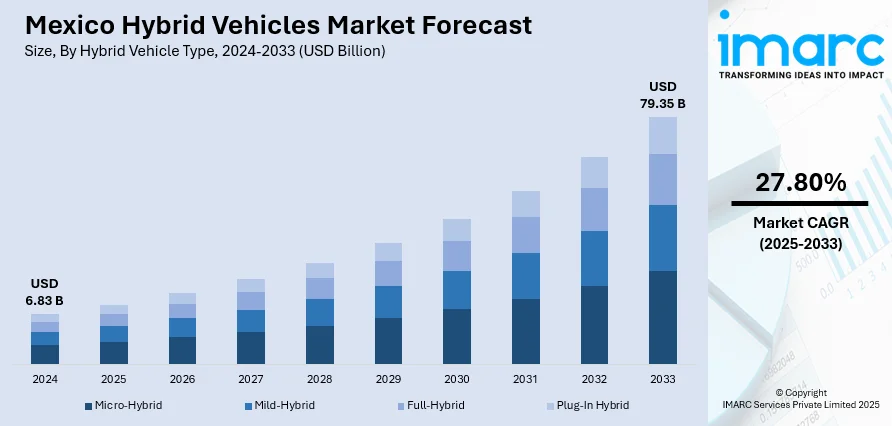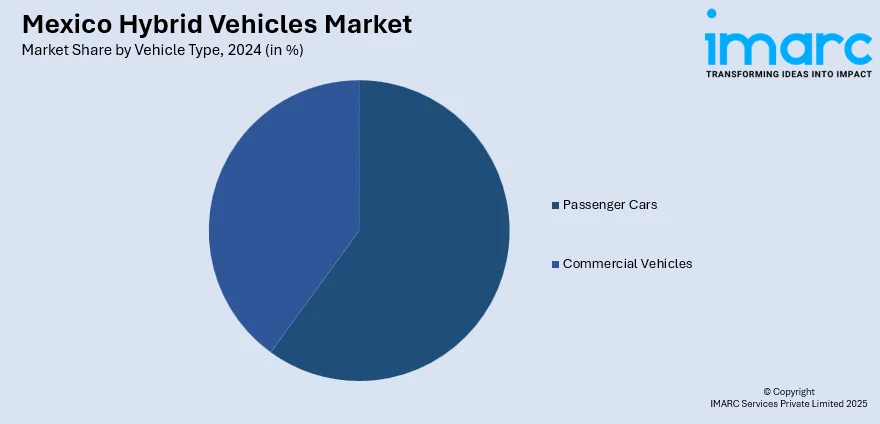
Mexico Hybrid Vehicles Market Size, Share, Trends and Forecast by Hybrid Vehicle Type, Vehicle Type, and Region, 2025-2033
Mexico Hybrid Vehicles Market Overview:
The Mexico hybrid vehicles market size reached USD 6.83 Billion in 2024. Looking forward, IMARC Group expects the market to reach USD 79.35 Billion by 2033, exhibiting a growth rate (CAGR) of 27.80% during 2025-2033. The market is expanding due to growing environmental awareness, stricter emission regulations, and rising fuel costs. Government incentives and increased model availability are also encouraging the adoption of hybrid vehicles. Urban consumers favoring hybrid vehicles for efficiency and sustainability, and automakers investing in production capacity are further fueling the Mexico hybrid vehicles market share.
|
Report Attribute
|
Key Statistics
|
|---|---|
|
Base Year
|
2024 |
|
Forecast Years
|
2025-2033
|
|
Historical Years
|
2019-2024
|
| Market Size in 2024 | USD 6.83 Billion |
| Market Forecast in 2033 | USD 79.35 Billion |
| Market Growth Rate 2025-2033 | 27.80% |
Mexico Hybrid Vehicles Market Trends:
Environmental Concerns and Government Policies
Increasing awareness about environmental degradation and the harmful effects of vehicle emissions is a key driver of hybrid vehicle adoption in Mexico. The government has implemented stricter emission regulations aligned with international environmental standards, encouraging consumers to shift toward greener transportation options. Policies such as tax incentives, import duty reductions, and exemption from certain environmental restrictions (like Hoy No Circula) make hybrid vehicles more attractive. These regulatory frameworks promote sustainability and help reduce urban air pollution, particularly in major cities like Mexico City and Guadalajara. Public campaigns and educational efforts further reinforce the environmental benefits of hybrid vehicles. As climate change remains a pressing issue, government support and environmental consciousness continue to play a pivotal role in driving the Mexico hybrid vehicle market growth.

Rising Fuel Prices and Cost Efficiency
The ongoing increase in global fuel prices significantly impacts Mexican consumers, who are increasingly seeking cost-efficient alternatives to conventional gasoline-powered vehicles. Hybrid vehicles offer superior fuel economy, which translates to substantial long-term savings on fuel expenditures. This cost efficiency is especially appealing to middle-class and urban consumers who face daily commutes. Additionally, hybrids often have lower maintenance costs compared to internal combustion engine vehicles, further enhancing their value proposition. As fuel costs continue to strain household budgets, the financial advantage of hybrid vehicles becomes more evident. This shift in consumer behavior is fostering a steady rise in demand for hybrid models across various vehicle categories. The ability to balance performance with fuel savings makes hybrids a practical and economically viable option for many Mexicans.
Rapid Urbanization and Growing Demand for Sustainable Transport
Mexico’s rapid urbanization has led to increasing traffic congestion, air pollution, and pressure on public transport systems. In response, there is growing consumer interest in sustainable and efficient personal mobility solutions. Hybrid vehicles offer a cleaner alternative for daily urban commuting while reducing fuel consumption and emissions. Their quiet operation and compact designs also align well with the needs of dense metropolitan areas. Younger, environmentally conscious urban dwellers are especially drawn to hybrid models for their eco-friendly appeal and technological innovation. As Mexico’s cities continue to expand, the demand for low-emission vehicles that meet urban mobility needs is set to grow. This urban lifestyle shift is playing a critical role in driving the hybrid vehicle market and shaping consumer preferences.
Mexico Hybrid Vehicles Market Segmentation:
IMARC Group provides an analysis of the key trends in each segment of the market, along with forecasts at the country and regional levels for 2025-2033. Our report has categorized the market based on hybrid vehicle type and vehicle type.
Hybrid Vehicle Type Insights:
- Micro-Hybrid
- Mild-Hybrid
- Full-Hybrid
- Plug-In Hybrid
The report has provided a detailed breakup and analysis of the market based on the hybrid vehicle type. This includes micro-hybrid, mild-hybrid, full-hybrid, and plug-in hybrid.
Vehicle Type Insights:

- Passenger Cars
- Commercial Vehicles
A detailed breakup and analysis of the market based on the vehicle type have also been provided in the report. This includes passenger cars and commercial vehicles.
Regional Insights:
- Northern Mexico
- Central Mexico
- Southern Mexico
- Others
The report has also provided a comprehensive analysis of all the major regional markets, which include Northern Mexico, Central Mexico, Southern Mexico, and others.
Competitive Landscape:
The market research report has also provided a comprehensive analysis of the competitive landscape. Competitive analysis such as market structure, key player positioning, top winning strategies, competitive dashboard, and company evaluation quadrant has been covered in the report. Also, detailed profiles of all major companies have been provided.
Mexico Hybrid Vehicles Market News:
- In May 2025, Swedish carmaker Lynk & Co. plans to join up with Chinese automaker Zeekr to enter the Mexican market. The program's goal is to encourage Mexico to use hybrid and electric cars.
- In April 2023, MG Motor announced the introduction of a plug-in hybrid SUV in Mexico, as the need for hybrid and electric vehicles increases across the Latin American nation, even with inadequate infrastructure and elevated costs for residents.
Mexico Hybrid Vehicles Market Report Coverage:
| Report Features | Details |
|---|---|
| Base Year of the Analysis | 2024 |
| Historical Period | 2019-2024 |
| Forecast Period | 2025-2033 |
| Units | Billion USD |
| Scope of the Report |
Exploration of Historical Trends and Market Outlook, Industry Catalysts and Challenges, Segment-Wise Historical and Future Market Assessment:
|
| Hybrid Vehicle Types Covered | Micro-Hybrid, Mild-Hybrid, Full-Hybrid, Plug-In Hybrid |
| Vehicle Types Covered | Passenger Cars, Commercial Vehicles |
| Regions Covered | Northern Mexico, Central Mexico, Southern Mexico, Others |
| Customization Scope | 10% Free Customization |
| Post-Sale Analyst Support | 10-12 Weeks |
| Delivery Format | PDF and Excel through Email (We can also provide the editable version of the report in PPT/Word format on special request) |
Key Questions Answered in This Report:
- How has the Mexico hybrid vehicles market performed so far and how will it perform in the coming years?
- What is the breakup of the Mexico hybrid vehicles market on the basis of hybrid vehicle type?
- What is the breakup of the Mexico hybrid vehicles market on the basis of vehicle types?
- What is the breakup of the Mexico hybrid vehicles market on the basis of region?
- What are the various stages in the value chain of the Mexico hybrid vehicles market?
- What are the key driving factors and challenges in the Mexico hybrid vehicles market?
- What is the structure of the Mexico hybrid vehicles market and who are the key players?
- What is the degree of competition in the Mexico hybrid vehicles market?
Key Benefits for Stakeholders:
- IMARC’s industry report offers a comprehensive quantitative analysis of various market segments, historical and current market trends, market forecasts, and dynamics of the Mexico hybrid vehicles market from 2019-2033.
- The research report provides the latest information on the market drivers, challenges, and opportunities in the Mexico hybrid vehicles market.
- Porter's five forces analysis assist stakeholders in assessing the impact of new entrants, competitive rivalry, supplier power, buyer power, and the threat of substitution. It helps stakeholders to analyze the level of competition within the Mexico hybrid vehicles industry and its attractiveness.
- Competitive landscape allows stakeholders to understand their competitive environment and provides an insight into the current positions of key players in the market.
Need more help?
- Speak to our experienced analysts for insights on the current market scenarios.
- Include additional segments and countries to customize the report as per your requirement.
- Gain an unparalleled competitive advantage in your domain by understanding how to utilize the report and positively impacting your operations and revenue.
- For further assistance, please connect with our analysts.
 Request Customization
Request Customization
 Speak to an Analyst
Speak to an Analyst
 Request Brochure
Request Brochure
 Inquire Before Buying
Inquire Before Buying




.webp)




.webp)












